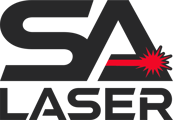Comprehensive Guide to Setting Up and Using a Rotary Attachment in Lightburn for CO2 Lasers
This guide explains the process of setting up a rotary attachment in Lightburn for CO2 lasers. It covers the alignment, focus, and operation to ensure accurate rotary engraving.
Step 1: Rotary Setup and Alignment
-
Lower the Work Bed
- Use the Z button with the down arrow on the wireless remote or the Ruida keypad to lower the work bed all the way down.
-
Place the Rotary
- Position the rotary on the work bed with the chuck on the left side and the support cone on the right side.
-
Move the Laser Head
- Use the X and Y movement keys on the wireless remote or Ruida keypad to move the laser head to the top of the central shaft by the chuck. Verify the position using the red dot.
-
Align the Support Cone
- Move the laser to the top of the central shaft holding the support cone. Pivot the cone side of the rotary as needed to align it under the red dot.
- Do not use the Y-axis movement keys to align the support cone side to avoid misalignment.
- Double-check the alignment on the chuck side by moving the rotary, not the Y-axis.
-
Enable Rotary in Lightburn
- Return to Lightburn and click the Rotary Setup button at the top of the screen.
- Select the Chuck radio button and enable the rotary slider (green when enabled).
- Ensure the mirror output slider is off (maroon colored) and select the Y-axis radio button.
- Set the steps per rotation to the default value of 10,000.
- Measure the diameter or circumference of your workpiece using a caliper or measuring tape and enter the value into the corresponding text box.
- Click OK.
-
Connect the Rotary Cable
- Plug the rotary cable into the rotary input located inside the machine on the right side. Ensure the notches are aligned and secure the cable by tightening the washer nut.
- Flip the switch on the right side of the machine towards the rotary option.
Step 2: Load Your Workpiece
- Insert the Chuck Key
- Insert the chuck key into the square holes in the rotary chuck and adjust the jaws as needed to secure your workpiece.
- Press the object against the vertical stops of the jaws and tighten the grip on your workpiece.
Step 3: Set Focus, Origin, and Settings
-
Set the Focus
- Set the focus of your workpiece. Once focused, remove the cone from the lens tube to reduce the chance of collision with the rotary.
- A collision can cause issues with the nozzle, lens, and belt drive.
-
Set the Origin
- Choose User Origin from the start from drop-down menu. Determine the job origin based on your alignment preference and job requirements.
- Apply the desired engraving settings from the library or input settings manually in the Cuts and Layers window.
- If the library tab is not visible, enable it from the Window menu at the top.
Step 4: Size and Orient Your Graphic
- Adjust the Graphic Size
- Adjust the size of your graphic to fit your workpiece.
- Rotate the graphic 90° counterclockwise or clockwise, depending on how your workpiece sits in the chuck.
- Use the selector tool and press the period or comma key on your keyboard for quick rotation.
- Ensure the height of your graphic matches the circumference of your object for a full wrap-around.
Step 5: Frame and Engrave
-
Frame the Graphic
- Note that the rotary has borders similar to the flatbed. Rotate the rotary one direction until it stops, then rotate it in the opposite direction at least one full rotation to ensure complete engraving.
-
Preview and Start Engraving
- Click Frame to ensure the graphic is the right size and positioned correctly.
- Click the Preview button to see how your graphic will engrave and estimate the engraving time.
- Turn on the exhaust and press Start to begin the rotary engraving.
Conclusion
By following these steps, you can set up and use a rotary attachment in Lightburn for CO2 lasers effectively. Proper alignment and settings ensure accurate and efficient rotary engraving. For further assistance, refer to Lightburn documentation or support channels. Happy engraving!
